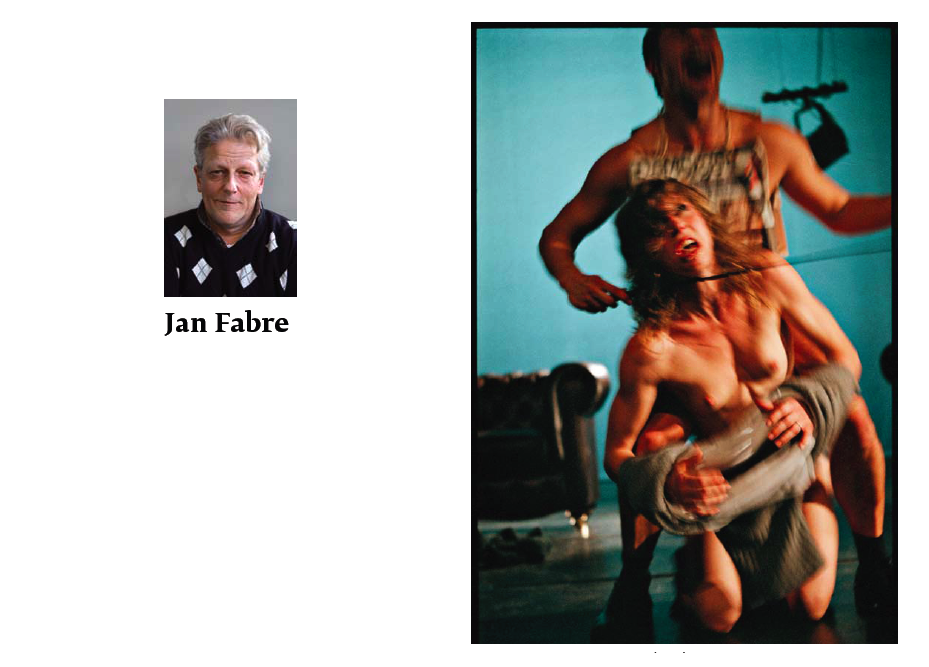
He greeted us in Angelos, the space in which he comes up with his dreamlike works. Aside from his great artisty, Jan Fabre is a passionate and extremely interesting man.
Do you enjoy being interviewed? It depends on the interviewer and the questions. I like interviews with people who know my work, so that an interesting dialogue can occur.
You are one of the most multidisciplinary figures in the art world, being a visual artist, stage director, choreographer and playwright. Do you ever find that confusing in terms of defining yourself as an artist? I choose the appropriate medium for each idea that I have. I am not a multimedia artist, you can say I’m sort of a “consilience” artist; this is a term from the 18th century that means a tool that you can give several interpretations with. That’s what I’ve been doing for more than thirty years in my artwork.
Do you still have the same urge to put insects or liquids under the microscope? My work has always been a systematic laboratorial research of things. I make drawings with my own tears, blood and sperm and by doing so I discovered many things concerning the human body, for example the typology of tears.
What’s the purpose of such a research? To open new fields of thinking, to get an insight of the body, because the body is a trap, a battlefield or a love installation but it also is a terra incognita.
Last year you had a rather original solo exhibition – when the Louvre Museum offered you the space in the Northern School wing and your artwork interacted with those of masters of the past. Did you feel any fear or hesitation? It took three years of preparation, I visited the spaces many times and we made lots of maquettes but I have to admit that when I finally got to installing my works, I skipped almost thirty of them. These masterpieces on the wall, the works of Rembrandt, Brueghel, Rubens, they tell you when it’s not good enough, you have to be very humble and exact in what you do there.
On some occasions you have been accused of trying too hard to shock the audience with the use of body liquids, stuffed animals, insects, bones etc. Do you ever get shocked yourself? Yes, often. I get shocked by the way our society functions, by the news on TV. Concerning my work, I don’t provoke people on purpose, so I get shocked when they sometimes have aggressive reactions: you perform in the theatre, the light goes off and people act like a mass, they shout at me and the performers or throw bottles on stage.
Your latest play, “Orgy of Tolerance”, represents your views on society; do you plan to expand it on a different level? Working with my company is an ongoing process. The play premiered a couple of months ago in Chile, then moved to New York, Germany, Belgium and the performance itself has already changed, so it’s possible that when I am in Athens the production will be extremely different. Theater work for me is about constantly evolving, challenging myself and the performers and posing new questions.
Should we expect to see something else during your presence in Athens this summer? Apart from the performances of “Orgy of tolerance” in Pallas Theater, I am preparing two different exhibitions with two Greek curators, one big solo exhibition for Greece and another small one for Athens. How many people comprise your team, including Troubleyn company? Troubleyn (Staying Faithful in old Flemish) is a laboratory for the body and the voice and also for people who support my theatre work, it has ten permanent people in staff. There is also Angelos, the office for visual arts where I have my studios, five more people work there. I have only one assistant, because I do a lot of my work on my own.
You seem to belong to the category of artists who are enjoying the process of their work instead of suffering? I am a contemporary mystic; I am a very happy artist, I love the things I do. You know the mystics were people put down by the Catholic Church, due to their joy towards life, in a sense I am one too. I have to make my artwork, my drawings or writings, to direct, I have to keep my mind busy, it is the main source of energy and joy in my life.
You were born in Antwerp and still live and work there. How come you never moved somewhere else? I did, I lived in New York for a year and a half, while teaching in a school of visual arts but I left. I was so tired of New York, it was too empty and fake and it made me look back in my cultural heritage, only to realize how rich it is and to fall in love with it again.
However, Antwerp is internationally known regarding fashion & design and you‘ve never seemed to be driven towards these areas? For me fashion has a lot in common with the news on TV, it’s not consistent. I do have respect for some people of my generation who did interesting things in these fields, but it doesn’t attract me
Over all these years of creating and presenting your work to the world, did you ever think about evaluating what you’ve been doing? Every day! Being an artist is a choice of life, a choice of interrogating and terrorizing your own mind, and I often wonder what it is I have to do in order to stay truthful to my actions and my work. It’s an ongoing process, sometimes you have to cross oceans to finally find piece and quiet. From time to time I imagine myself at the age of 86, sitting on the grass making single small drawings and writings.






